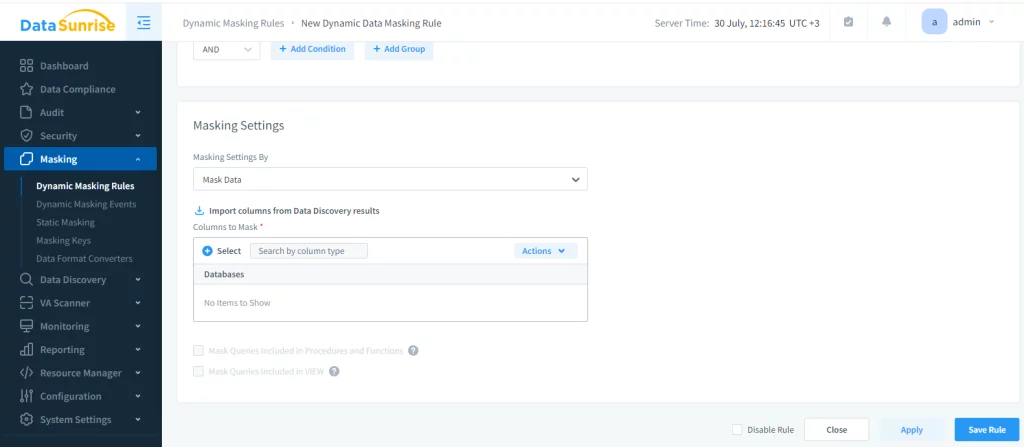
Enhancing Data Security with Dynamic Data Masking in Oracle

Oracle databases serve as vital repositories for sensitive information across countless organizations. As data privacy concerns intensify, companies need robust solutions to protect confidential data without compromising functionality. Dynamic data masking emerges as a powerful tool in this ongoing battle for data security.
What is Dynamic Data Masking?
At its core, dynamic data masking acts as a protective shield for sensitive information. It operates by concealing or altering data in real-time as users access it. This process replaces actual values with masked versions, effectively preventing unauthorized individuals from viewing confidential details. The beauty of this approach lies in its ability to safeguard data without modifying the original database contents.
Oracle’s Implementation of Dynamic Data Masking
Oracle has integrated dynamic data masking capabilities directly into its database engine. This implementation works at the query level, applying masking rules before returning results to users. The process happens transparently, requiring no changes to existing applications or workflows.
Oracle offers a range of masking techniques to suit various security needs. Full masking replaces entire values with asterisks or fixed characters, providing maximum protection for highly sensitive data. Partial masking allows for more nuanced approaches, such as hiding only the last four digits of a credit card number.
For scenarios requiring realistic-looking data, random masking substitutes original values with plausible alternatives. Organizations with specific requirements can create custom masking rules tailored to their unique needs.
Setting Up Dynamic Data Masking in Oracle
Implementing dynamic data masking in Oracle using DataSunrise involves a structured approach. You must set up an instance of the Database in the DataSunrise server before anything else.

Database administrators must first identify the columns containing sensitive information by configuring masking rule in the corresponding section. This step requires a thorough understanding of the data landscape and potential security risks.

Once you identify sensitive columns, you need to create masking policies in the next phase. These policies establish the rules for masking each piece of sensitive data. Oracle provides tools and interfaces to simplify this process, allowing administrators to craft effective masking strategies.
After policy creation, the next step is to apply these policies to specific database objects and users. This granular approach ensures that masking rules precisely enforce where needed. Testing and verification are important to make sure that masking works correctly for all user roles and query types.
Real-World Examples of Oracle Dynamic Data Masking
To illustrate the power of dynamic data masking, consider a few practical examples. In a financial database, credit card numbers might appear as “XXXX-XXXX-XXXX-3456”, revealing only the last four digits.
Email addresses could be masked as “j***@example.com”, preserving the domain while hiding personal details. Social Security Numbers might display as “XXX-XX-6789”, concealing most of the identifier while maintaining its format.
These examples demonstrate how dynamic data masking strikes a balance between security and usability. Masked data retains its structure and partial information, allowing authorized users to perform necessary tasks without exposing sensitive details.
Benefits and Challenges of Oracle Dynamic Data Masking
The advantages of implementing dynamic data masking in Oracle environments are numerous. It significantly enhances data security by shielding sensitive information from prying eyes. This protection extends to both internal and external threats, reducing the risk of data breaches and unauthorized access.
Dynamic data masking also simplifies compliance with various privacy regulations. By automatically concealing sensitive data, organizations can more easily meet the stringent requirements of laws like GDPR or CCPA. The flexibility of Oracle’s masking features allows for granular control, enabling companies to tailor their approach to specific regulatory needs.
However, implementing dynamic data masking is not without challenges. Complex masking rules can potentially impact query performance, requiring careful optimization. Managing masking policies across large databases demands meticulous organization and ongoing maintenance. Ensuring data consistency across related tables while applying masking rules presents another hurdle for database administrators to overcome.
Integrating with Other Oracle Security Features
To create a comprehensive security strategy, organizations should consider integrating dynamic data masking with other Oracle security features. Data encryption protects information at rest and in transit, complementing the real-time protection offered by masking. Robust access controls further restrict user permissions based on roles and responsibilities. Implementing thorough auditing measures allows companies to track database activities and detect potential security breaches.
By combining these security layers, organizations can create a formidable defense against data threats. This multi-faceted approach addresses various vulnerabilities and provides a more complete security posture for Oracle databases.
The Future of Dynamic Data Masking in Oracle
As data protection needs continue to evolve, Oracle is likely to enhance its dynamic data masking capabilities. We may see the emergence of AI-driven masking algorithms capable of automatically identifying and protecting sensitive data. Seamless integration between on-premises and cloud databases will become increasingly important as organizations adopt hybrid infrastructures. Real-time policy updates based on threat intelligence could provide more adaptive and responsive masking strategies.
These potential advancements underscore the ongoing importance of dynamic data masking in Oracle’s security ecosystem. As threats to data privacy grow more sophisticated, this technology will play a crucial role in safeguarding sensitive information.
Conclusion
Dynamic data masking for Oracle offers a powerful solution for protecting sensitive data in today’s complex security landscape. By implementing this feature, organizations can enhance their data security, meet compliance requirements, and mitigate risks associated with data breaches. Dynamic data masking is important for protecting valuable information in Oracle databases as the digital world evolves.
